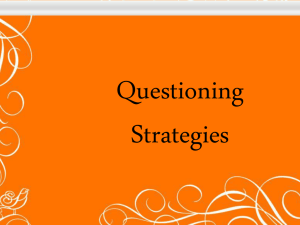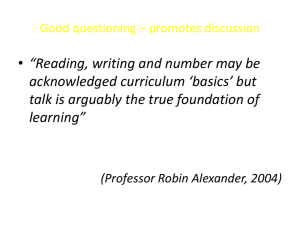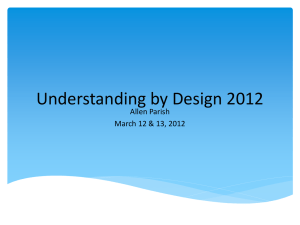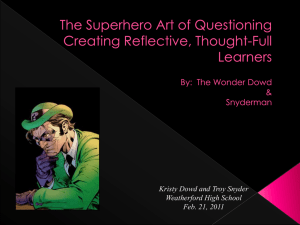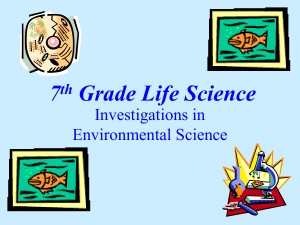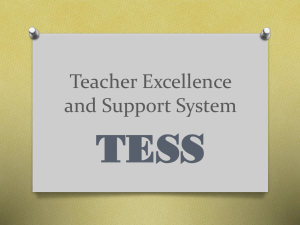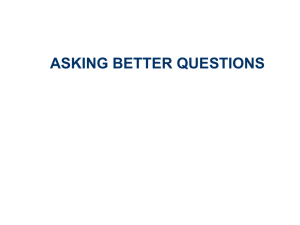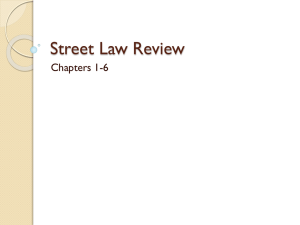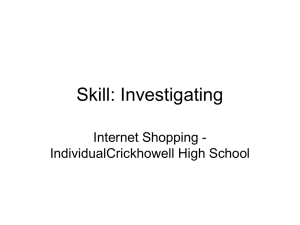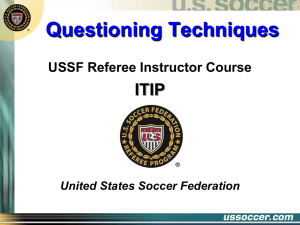Fazal_Noorin_IOP_May7_2011
advertisement
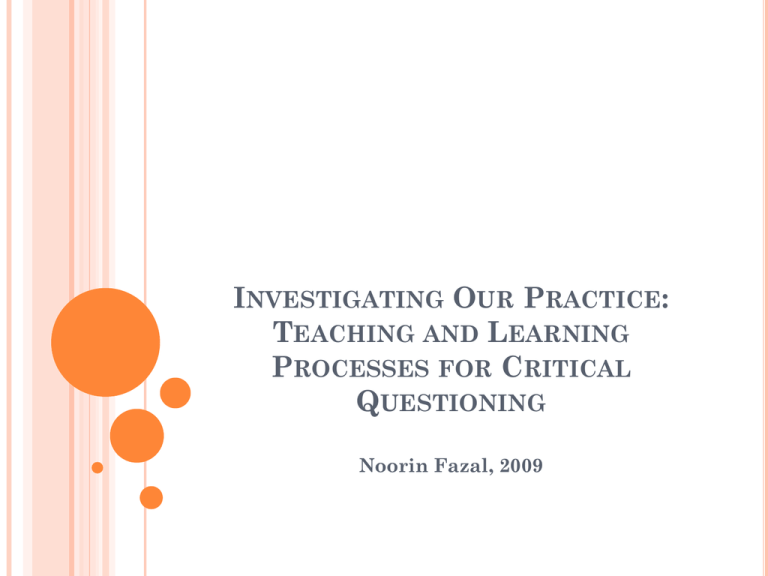
INVESTIGATING OUR PRACTICE: TEACHING AND LEARNING PROCESSES FOR CRITICAL QUESTIONING Noorin Fazal, 2009 INSPIRATION FROM A GERMAN POET “… try to love the questions themselves as if they were locked rooms or books written in a very foreign language…” - Rilke, 1903 THE RESEARCH STUDY: 2009 Context: A Grade 9/10 classroom in North Vancouver, BC Research Question: How can I engage students in the process of critical questioning in the Canadian RE context? Sample Size: 10 students Duration of Study: 5 Weeks Qualitative, Action Research AIMS OF THE STUDY As summarized by Dillon (1988) who writes, “the first pedagogical act is to understand. Practice follows, inspired by an appreciative and informative understanding of student questions— their service to learning and teaching, their place in the classroom, the conditions under which they emerge or hide, the process they follow from initial perplexity through to eventual learning” (p.7). CRITICAL THINKING AND CRITICAL QUESTIONING IN THE LITERATURE “Critical thinking is skilled and active interpretation and evaluation of observations and communications, information and argumentation” (Fisher and Scriven 1997, p.21) Dillon (1988) suggests that “just as asking precedes answering in the questioning process, so do student questions precede teacher questions in the learning process … Students create a relationship between their question and the answers that are constructed” (p.7) Frameworks can aim to “identify the component processes, skills and abilities” involved in critical thinking (Moon 2008, p.41). CHOOSING A FRAMEWORK From Barell (2003) S Source What is the source? Who said it? In what setting or context? Is it believable? E Evidence What evidence is presented to support the claim? Is it objective, accurate, reliable, and representative? A Assumptions What assumptions are being made or implied? Are they realistic and valid? D Definitions What definitions of key terms are being used? Is the language clear, unambiguous, and specific? S Slant What is the slant, bias, or special interest reflected in the statement? What might be the motivation of the people who made the statement? DATA COLLECTION METHODS Observations, personal and collaborative reflections, audio recording, and student work Phase 1: Diagnostic (Purpose of Questions) Phase 2: Modeling and Practicing (SEADS Framework) Phase 3: Gaining Student Feedback (Good Question?) Phase 4: Metacognition (Reframing the Question) Phase 5: Reflection (Experience) * Please Note: Phases Overlapped INVESTIGATING OUR PRACTICE Students judge their own questions Student A: “A good question is almost everything” Student A also mentioned the possibility of the ‘stupid’ question Students benefitted from a framework Student B: SEADS helped to think “deeper” Student C: “Last week, I had said that SEADS “didn’t generate any Qs [questions] better than what I am capable of”. However, during this week’s family chat, SEADS did generate Qs, very very good Qs I believe”. Students need modeling and practice Co-teaching INVESTIGATING OUR PRACTICE Students can meta-question Student D: “What governments are actually working & have been working at their MDG promises and plan to keep their 2015/2025 goal?” After SEADS, Student D: “ARE THERE ANY governments working towards their MDG promise & plan to keep their 2015/2025 goal?” INVESTIGATING OUR PRACTICE Students expressed frustration Student E: “I feel it limits me to the questions I can ask and how to phrase them” Framework as a tool for learning Student E learned “about different situations people find themselves in” and that she “had more empathy towards them” as a result. She also wrote, “the videos meant the most to me because it helped me experience people’s lives and emotions” RECONCEPTUALIZING CRITICAL THINKING Modifying Scriven’s Definition: “critical thinking is skilled and active interpretation and evaluation of experiences and communications, information and argumentation, situated in a paradigm of compassion, respect, and commitment”. Modifying Barell’s Framework: SEADS-P(ersonal) QUESTIONS TO CONSIDER AS WE TEACH Am I creating space for my students to ask questions? How? Am I supporting the process of student questioning in the classroom? How? What is the role of emotion and experience in critical thinking? LAST THOUGHTS… “Live the questions now. Perhaps then, someday far in the future, you will gradually, without even noticing it, live your way into the answer. - Rilke, 1903 REFERENCES Barell, J., 2003. Developing more curious minds. Alexandria: Association for Supervision and Curriculum Development. Dillon, J.T., 1988. Questioning and Teaching. London: Croomhelm. Fisher, A & Scriven, M., 1997. Critical thinking: its definition and assessment. Edgepress and Centre for Research in Critical Thinking, University of East Anglia. Moon, J., 2008. Critical thinking – an exploration of theory and practice. London: Routledge.
